2010 Hyundai H-100 Truck weight
[x] Cancel search: weightPage 5 of 207
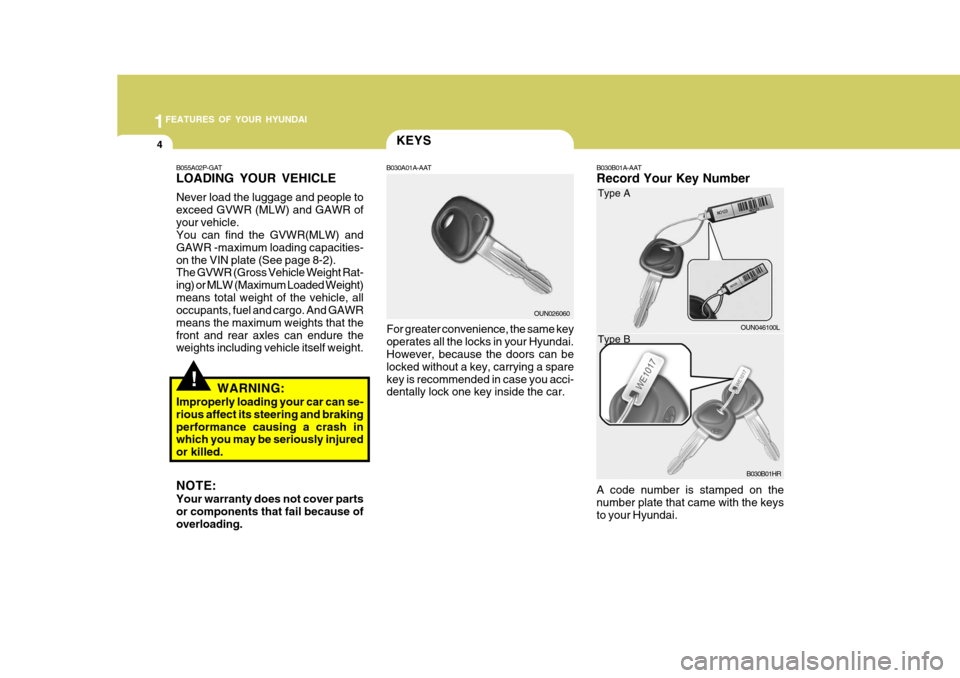
1FEATURES OF YOUR HYUNDAI
4
B030B01A-AAT Record Your Key Number A code number is stamped on the number plate that came with the keysto your Hyundai.KEYS
B030A01A-AAT
For greater convenience, the same key operates all the locks in your Hyundai. However, because the doors can be locked without a key, carrying a sparekey is recommended in case you acci- dentally lock one key inside the car.
!
B055A02P-GAT LOADING YOUR VEHICLE Never load the luggage and people to exceed GVWR (MLW) and GAWR ofyour vehicle. You can find the GVWR(MLW) and GAWR -maximum loading capacities-on the VIN plate (See page 8-2). The GVWR (Gross Vehicle Weight Rat- ing) or MLW (Maximum Loaded Weight)means total weight of the vehicle, all occupants, fuel and cargo. And GAWR means the maximum weights that thefront and rear axles can endure the weights including vehicle itself weight. WARNING:
Improperly loading your car can se- rious affect its steering and brakingperformance causing a crash in which you may be seriously injured or killed. NOTE: Your warranty does not cover parts or components that fail because ofoverloading.
OUN026060
Type A
B030B01HR
OUN046100L
Type B
Page 10 of 207
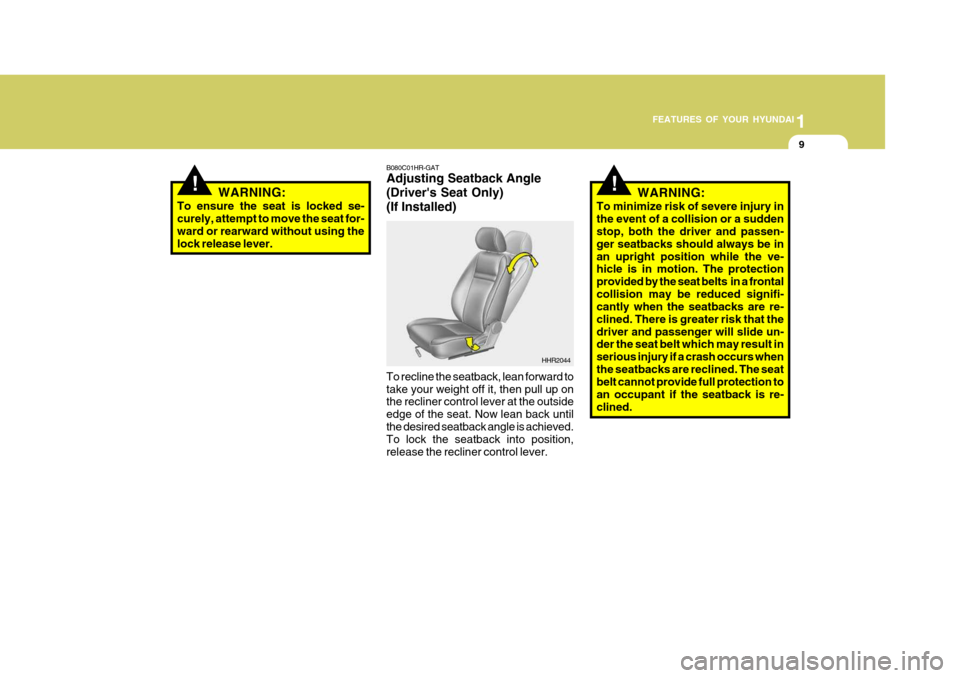
1
FEATURES OF YOUR HYUNDAI
9
!
B080C01HR-GAT Adjusting Seatback Angle (Driver's Seat Only)(If Installed)
HHR2044
WARNING:
To ensure the seat is locked se- curely, attempt to move the seat for- ward or rearward without using thelock release lever.
!WARNING:
To minimize risk of severe injury in the event of a collision or a sudden stop, both the driver and passen- ger seatbacks should always be inan upright position while the ve- hicle is in motion. The protection provided by the seat belts in a frontalcollision may be reduced signifi- cantly when the seatbacks are re- clined. There is greater risk that thedriver and passenger will slide un- der the seat belt which may result in serious injury if a crash occurs whenthe seatbacks are reclined. The seat belt cannot provide full protection to an occupant if the seatback is re-clined.
To recline the seatback, lean forward totake your weight off it, then pull up on the recliner control lever at the outside edge of the seat. Now lean back untilthe desired seatback angle is achieved. To lock the seatback into position, release the recliner control lever.
Page 38 of 207

1
FEATURES OF YOUR HYUNDAI
37HEADLIGHT LEVELING DE- VICE SYSTEM
Switch position
0 1
Loading condition
Driver only Driver + PermissibleRR axle loadB340G01HR-GAT (Left-hand Drive Type) (If Installed)
To adjust the headlight beam level ac- cording to the number of the passen- gers and the loading weight in the cargo area, turn the beam leveling switch.The higher the number of the switch position, the lower the headlight beam level. Always keep the headlight beamat the proper leveling position, or head- lights may dazzle other road users. Listed below are the examples of properswitch settings. For loading conditions other than those listed below, adjust the switch position so that the beamlevel may be the nearest as the condi- tion obtained according to the list. B340G01HR
FOG LIGHT SWITCH
OHR028100
B360B01FC-GAT Front Fog Light Switch (If Installed)
To turn on the front fog lights, push the switch in the "ON" position. They willlight when the headlight switch is in the first or second position.
Page 115 of 207
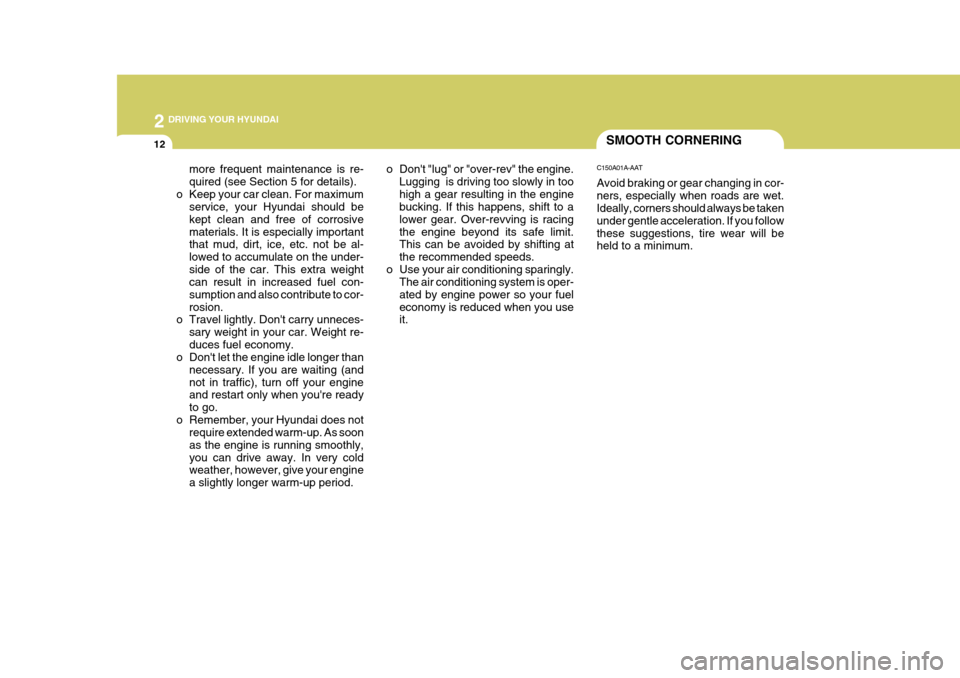
2 DRIVING YOUR HYUNDAI
12SMOOTH CORNERING
C150A01A-AAT Avoid braking or gear changing in cor- ners, especially when roads are wet. Ideally, corners should always be taken under gentle acceleration. If you followthese suggestions, tire wear will be held to a minimum.
more frequent maintenance is re- quired (see Section 5 for details).
o Keep your car clean. For maximum service, your Hyundai should bekept clean and free of corrosivematerials. It is especially important that mud, dirt, ice, etc. not be al- lowed to accumulate on the under-side of the car. This extra weight can result in increased fuel con- sumption and also contribute to cor-rosion.
o Travel lightly. Don't carry unneces-
sary weight in your car. Weight re-duces fuel economy.
o Don't let the engine idle longer than
necessary. If you are waiting (andnot in traffic), turn off your engine and restart only when you're ready to go.
o Remember, your Hyundai does not require extended warm-up. As soonas the engine is running smoothly,you can drive away. In very cold weather, however, give your engine a slightly longer warm-up period. o Don't "lug" or "over-rev" the engine.
Lugging is driving too slowly in toohigh a gear resulting in the engine bucking. If this happens, shift to a lower gear. Over-revving is racingthe engine beyond its safe limit. This can be avoided by shifting at the recommended speeds.
o Use your air conditioning sparingly. The air conditioning system is oper-ated by engine power so your fueleconomy is reduced when you use it.
Page 116 of 207
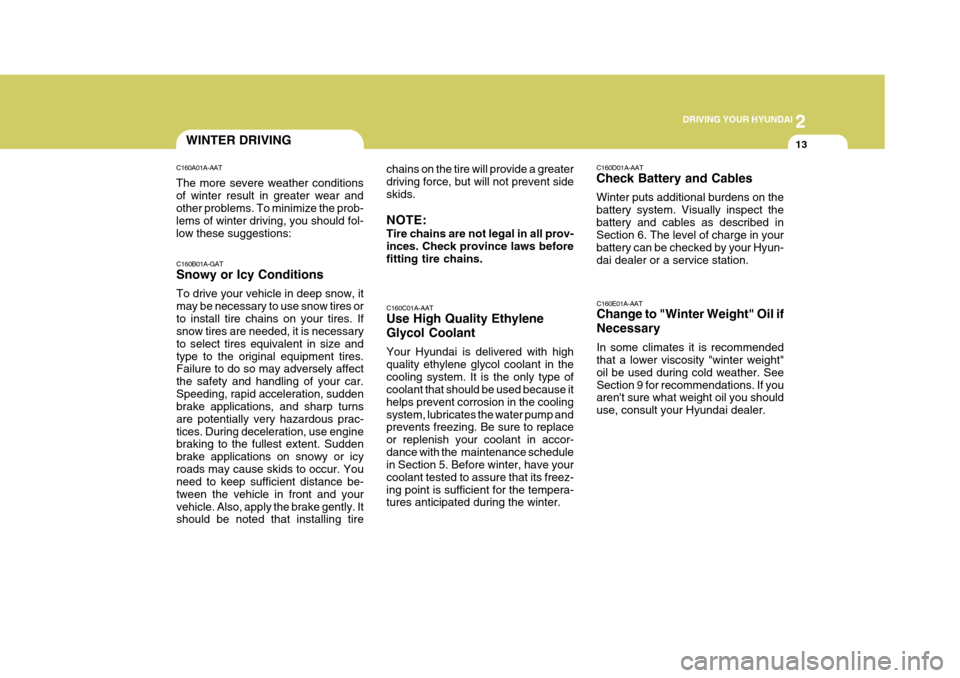
2
DRIVING YOUR HYUNDAI
13WINTER DRIVING
chains on the tire will provide a greater driving force, but will not prevent sideskids. NOTE: Tire chains are not legal in all prov- inces. Check province laws beforefitting tire chains. C160C01A-AAT Use High Quality Ethylene Glycol Coolant Your Hyundai is delivered with high quality ethylene glycol coolant in thecooling system. It is the only type of coolant that should be used because it helps prevent corrosion in the coolingsystem, lubricates the water pump and prevents freezing. Be sure to replace or replenish your coolant in accor-dance with the maintenance schedule in Section 5. Before winter, have your coolant tested to assure that its freez-ing point is sufficient for the tempera- tures anticipated during the winter.
C160A01A-AAT The more severe weather conditions of winter result in greater wear and other problems. To minimize the prob- lems of winter driving, you should fol-low these suggestions:
C160B01A-GAT Snowy or Icy Conditions To drive your vehicle in deep snow, it may be necessary to use snow tires orto install tire chains on your tires. If snow tires are needed, it is necessary to select tires equivalent in size andtype to the original equipment tires. Failure to do so may adversely affect the safety and handling of your car.Speeding, rapid acceleration, sudden brake applications, and sharp turns are potentially very hazardous prac-tices. During deceleration, use engine braking to the fullest extent. Sudden brake applications on snowy or icyroads may cause skids to occur. You need to keep sufficient distance be- tween the vehicle in front and yourvehicle. Also, apply the brake gently. It should be noted that installing tire C160D01A-AAT Check Battery and Cables Winter puts additional burdens on the battery system. Visually inspect thebattery and cables as described in Section 6. The level of charge in your battery can be checked by your Hyun-dai dealer or a service station.
C160E01A-AAT Change to "Winter Weight" Oil if Necessary In some climates it is recommended that a lower viscosity "winter weight" oil be used during cold weather. SeeSection 9 for recommendations. If you aren't sure what weight oil you should use, consult your Hyundai dealer.
Page 120 of 207
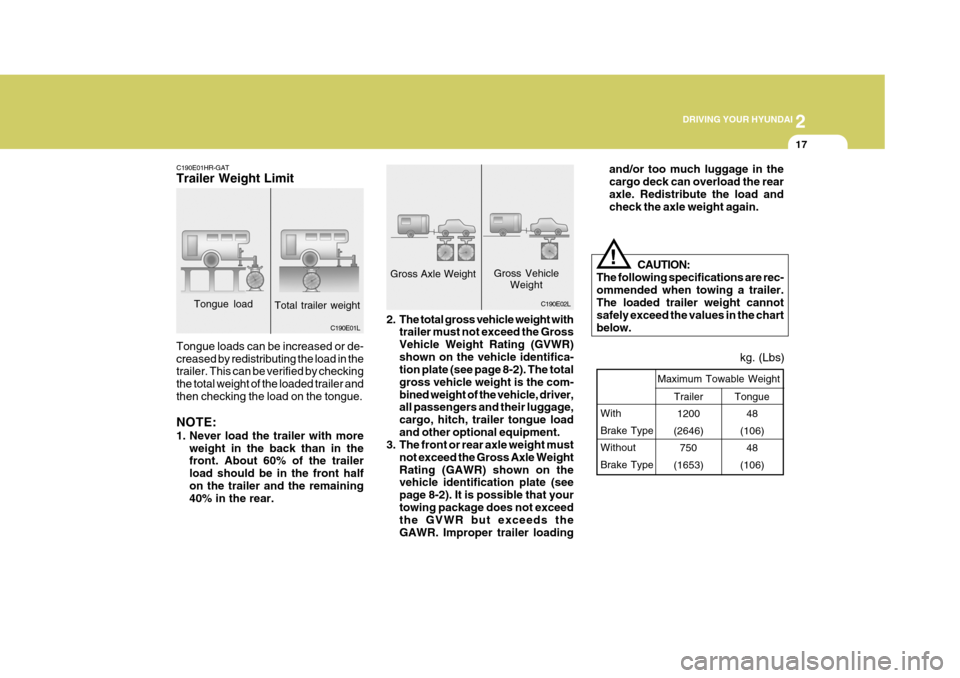
2
DRIVING YOUR HYUNDAI
17
C190E01L
C190E01HR-GAT Trailer Weight Limit
Tongue load Total trailer weight
Tongue loads can be increased or de- creased by redistributing the load in the trailer. This can be verified by checking the total weight of the loaded trailer andthen checking the load on the tongue. NOTE:
1. Never load the trailer with more weight in the back than in the front. About 60% of the trailer load should be in the front halfon the trailer and the remaining 40% in the rear. 2. The total gross vehicle weight with
trailer must not exceed the Gross Vehicle Weight Rating (GVWR)shown on the vehicle identifica- tion plate (see page 8-2). The total gross vehicle weight is the com-bined weight of the vehicle, driver, all passengers and their luggage, cargo, hitch, trailer tongue loadand other optional equipment.
3. The front or rear axle weight must
not exceed the Gross Axle WeightRating (GAWR) shown on the vehicle identification plate (see page 8-2). It is possible that yourtowing package does not exceed the GVWR but exceeds the GAWR. Improper trailer loading C190E02L
Gross Axle Weight
Gross Vehicle
Weight
and/or too much luggage in the cargo deck can overload the rearaxle. Redistribute the load and check the axle weight again.
CAUTION:
The following specifications are rec- ommended when towing a trailer. The loaded trailer weight cannot safely exceed the values in the chartbelow.
!
Maximum Towable Weight kg. (Lbs)
Trailer
1200
(2646) 750
(1653) Tongue
48
(106) 48
(106)
With Brake TypeWithoutBrake Type